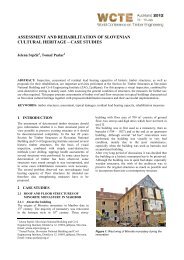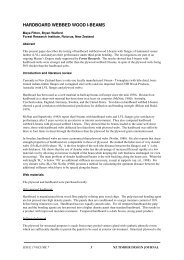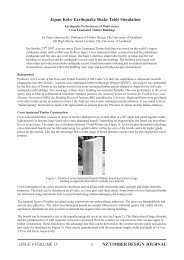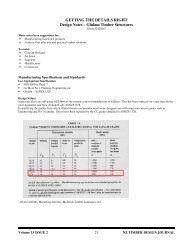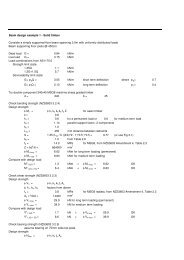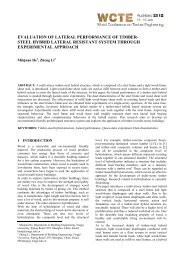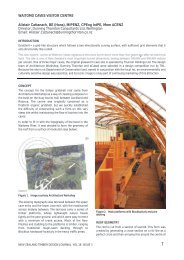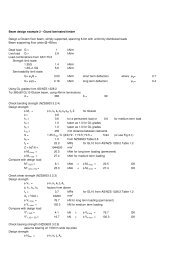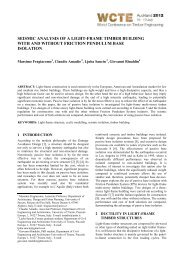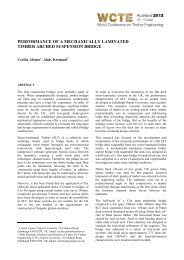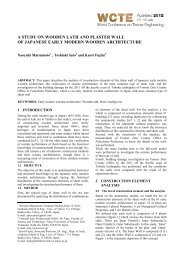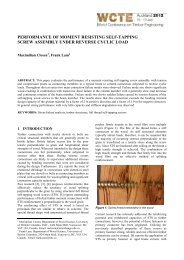00694 Pouyan Zarnani - Timber Design Society
00694 Pouyan Zarnani - Timber Design Society
00694 Pouyan Zarnani - Timber Design Society
You also want an ePaper? Increase the reach of your titles
YUMPU automatically turns print PDFs into web optimized ePapers that Google loves.
Predicted Average Strength [kN]<br />
Predicted Average Strength [kN]<br />
Predicted Average Strength [kN]<br />
(a)<br />
(b)<br />
(c)<br />
1800<br />
1600<br />
1400<br />
1200<br />
1000<br />
800<br />
600<br />
400<br />
1600<br />
1400<br />
1200<br />
1000<br />
800<br />
600<br />
400<br />
200<br />
1600<br />
1400<br />
1200<br />
1000<br />
800<br />
New Analytical M.<br />
r² = 0.87<br />
MAE=+0.9%<br />
STDEV=20.3%<br />
200<br />
New Analytical M.<br />
0<br />
0 200 400 600 800 1000 1200 1400 1600 1800<br />
Observed Average Test Strength [kN]<br />
Stahl's Method<br />
r² = 0.78<br />
MAE=+2.1%<br />
STDEV=29.4%<br />
0<br />
0 200 400 600 800 1000 1200 1400 1600<br />
Observed Average Test Strength [kN]<br />
EC5<br />
r² = 0.67<br />
MAE=+2.8%<br />
STDEV=28.7%<br />
Stahl's Method<br />
600<br />
O86-09 Code<br />
r² = 0.78<br />
400<br />
MAE=-23.2%<br />
STDEV=18.5%<br />
200<br />
O86-09 Code<br />
0<br />
EC5<br />
0 200 400 600 800 1000 1200 1400 1600<br />
Observed Average Test Strength [kN]<br />
Figure 13: Comparison of analyses and test data<br />
(current and literature data) in brittle/mixed failure modes;<br />
(a) new analytical method, (b) Stahl’s method, (c) O86<br />
code and EC5<br />
6 CONCLUSONS<br />
A close form stiffness-based analytical model to<br />
determine the wood resistance of riveted connections in<br />
timber products is proposed. It takes into account the<br />
stiffness and strength of the failure planes subjected to<br />
non-uniform shear and tension stresses in wood. Results<br />
of current tests and data available from literature confirm<br />
that this closed form analytical method can be used as<br />
design provision with more precise predictions for<br />
timber riveted connections. Based on the proposed<br />
design model, an efficient connection design can be<br />
made by decreasing the difference between the capacity<br />
of the wood and the rivets. The proposed method can be<br />
extended to other small dowel type fastener; e.g. nails<br />
and screws for connection design improvement and<br />
failure modes prediction.<br />
ACKNOWLEDGEMENTS<br />
The authors wish to thank the Structural <strong>Timber</strong><br />
Innovation Company (STIC) for funding this research<br />
work.<br />
REFERENCES<br />
[1] <strong>Zarnani</strong> P., Quenneville P.: New analytical method and<br />
experimental verification of timber rivet connections<br />
loaded parallel-to-grain. In proceedings of the CSCE<br />
Annual Conference, Struct Div, Ottawa, Canada, 2011.<br />
[2] Foschi R. O., Longworth J.: Analysis and design of<br />
griplam nailed connections. J Struct Div ASCE,<br />
101(12):2537-2555, 1975.<br />
[3] Canadian Standards Association (CSA). CAN/CSA-<br />
O86.09: Engineering design in wood (limit states<br />
design). Mississauga, Ontario, 2009.<br />
[4] American Forest and Paper Association (AF&PA).<br />
NDS-2001: National design specification (NDS) for<br />
wood construction. Washington, DC, 2001.<br />
[5] European Committee for Standardization (CEN). EN<br />
1995-1-1:2004: Eurocode 5-<strong>Design</strong> of timber<br />
structures. Brussels, Belgium, 2004.<br />
[6] Stahl D. C. , Wolfe R. W. , and Begel M.: Improved<br />
analysis of timber rivet connections. J Struct Eng<br />
ASCE, 130(8):1272-1279, 2004.<br />
[7] Johnsson H., Stehn L.: Plug shear failure in nailed<br />
timber connections: load distribution and failure<br />
initiation. Holz-als Roh und Werkstoff, 62:455-464,<br />
2004.<br />
[8] <strong>Zarnani</strong> P., Quenneville P.: Wood effective thickness in<br />
brittle and mixed failure modes of timber rivet<br />
connections. In proceedings of 12 th World Conference<br />
on <strong>Timber</strong> Engineering, New Zealand, 2012.<br />
[9] Johansen K. W.: Theory of timber connections.<br />
Publications of International Association for Bridge<br />
and Structural Engineering, 9:249-262, 1949.<br />
[10] <strong>Zarnani</strong> P., Quenneville P.: Consistent yield model for<br />
strength prediction of timber rivet connection under<br />
ductile failure. In proceedings of 12 th World<br />
Conference on <strong>Timber</strong> Engineering, New Zealand,<br />
2012.<br />
[11] International Organization for Standardization (ISO).<br />
ISO 6891:1983.<br />
[12] Begel M., Wolfe R. W., and Stahl D. C.: <strong>Timber</strong> rivet<br />
connections in US domestic species. Res Pap FPL-RP-<br />
619. Madison, WI: US Department of Agriculture,<br />
Forest Service, Forest Products Laboratory, 2004.<br />
[13] European Committee for Standardization (CEN). N<br />
408:2003: Structural timber and glued laminated<br />
timber-Determination of some physical and mechanical<br />
properties. Brussels, Belgium, 2003.<br />
[14] Standards Australia/ Standards New Zealand<br />
(AS/NZS). AS/NZS 4063.1, 2009.<br />
[15] Lindsay B.: Determination of characteristic shear<br />
strength values for Radiata Pine and LVL. Final Year<br />
Research Project Report, DCEE, University of<br />
Auckland, New Zealand, 2010.<br />
[16] Buchanan A. H., Lai J. C.: Glulam rivets in Radiata<br />
Pine. Can J Civ Eng, 21(2):340-350, 1994.<br />
[17] Karacabeyli E., Fraser H., and Deacon W.: Lateral and<br />
withdrawal load resistance of glulam rivet connections<br />
made with sawn timber. CJCE, 25(1):128-138, 1998.<br />
[18] Marjerrison M. R.: Analysis of timber rivet<br />
connections loaded parallel to grain. MSc dissertation,<br />
Department of Civil Eng, The Royal Military College<br />
of Canada, Kingston, Ontario, Canada, 2007.



